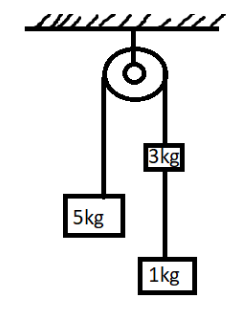
Three weights are hanging over a smooth fixed pulley as shown in the figure. What is the tension in the string connecting weights B and C?

(A) g
(B) g/9
(C) 8g/9
(D) 10g/9

Answer
546k+ views
Hint: This could be simply solved by breaking the diagrams into simple free body diagrams of both the blocks. Then we need to apply Newton’s law of motion.
Formula used:
Here, we will use the basic formula NLM-2:
$ {\text{F = ma}} $
Here, $ {\text{F}} $ is the force exerted on the block
$ {\text{m}} $ is the mass of the block
$ {\text{a}} $ is acceleration of the block
Complete step by step answer:
We already know that the bodies are connected together by rope,
So, both the bodies will have the same acceleration.
First, we will find the acceleration in the bodies.
Let us assume the acceleration of the block to be $ {\text{a}} $ ,
There will also be a tension $ {\text{T}} $ in the block on cutting the rope with which it is attached.
Using NLM-2:
$ {\text{F = ma}} $
For all the blocks:
$ {\text{a = }}\left( {\dfrac{{{\text{5 - 4}}}}{{{\text{5 + 4}}}}} \right){\text{g = g/9}} $
Also, for the block,
$ {\text{T - mg = ma}} $
$ \Rightarrow {\text{T = m}}\left( {{\text{g + a}}} \right) $
On solving, the above equations,
For 1 kg block,
$ {\text{T = 1}}\left( {{\text{g + }}\dfrac{{\text{g}}}{{\text{9}}}} \right){\text{ = }}\dfrac{{{\text{10g}}}}{{\text{9}}} $
Then we need to match the correct option.
The correct option is D.
Additional Information
A pulley is a wheel on an axle or shaft that is designed to support movement and change of direction of a taut cable or belt, or transfer of power between the shaft and cable or belt. In the case of a pulley supported by a frame or shell that does not transfer power to a shaft, but is used to guide the cable or exert a force, the supporting shell is called a block, and the pulley may be called a sheave
Note:
It should be always kept in mind that we should always draw the FBD of the body before solving any force questions. Also, we should never forget to assume tension force away from the body wherever there is rope in pulley or block questions. Similarly, spring forces also are a case of springs acting tensile (away) from the body. Also, if the bodies are connected together, they will have the same acceleration.
Formula used:
Here, we will use the basic formula NLM-2:
$ {\text{F = ma}} $
Here, $ {\text{F}} $ is the force exerted on the block
$ {\text{m}} $ is the mass of the block
$ {\text{a}} $ is acceleration of the block
Complete step by step answer:
We already know that the bodies are connected together by rope,
So, both the bodies will have the same acceleration.
First, we will find the acceleration in the bodies.
Let us assume the acceleration of the block to be $ {\text{a}} $ ,
There will also be a tension $ {\text{T}} $ in the block on cutting the rope with which it is attached.
Using NLM-2:
$ {\text{F = ma}} $
For all the blocks:
$ {\text{a = }}\left( {\dfrac{{{\text{5 - 4}}}}{{{\text{5 + 4}}}}} \right){\text{g = g/9}} $
Also, for the block,
$ {\text{T - mg = ma}} $
$ \Rightarrow {\text{T = m}}\left( {{\text{g + a}}} \right) $
On solving, the above equations,
For 1 kg block,
$ {\text{T = 1}}\left( {{\text{g + }}\dfrac{{\text{g}}}{{\text{9}}}} \right){\text{ = }}\dfrac{{{\text{10g}}}}{{\text{9}}} $
Then we need to match the correct option.
The correct option is D.
Additional Information
A pulley is a wheel on an axle or shaft that is designed to support movement and change of direction of a taut cable or belt, or transfer of power between the shaft and cable or belt. In the case of a pulley supported by a frame or shell that does not transfer power to a shaft, but is used to guide the cable or exert a force, the supporting shell is called a block, and the pulley may be called a sheave
Note:
It should be always kept in mind that we should always draw the FBD of the body before solving any force questions. Also, we should never forget to assume tension force away from the body wherever there is rope in pulley or block questions. Similarly, spring forces also are a case of springs acting tensile (away) from the body. Also, if the bodies are connected together, they will have the same acceleration.
Recently Updated Pages
Master Class 12 Economics: Engaging Questions & Answers for Success

Master Class 12 Maths: Engaging Questions & Answers for Success

Master Class 12 Biology: Engaging Questions & Answers for Success

Master Class 12 Physics: Engaging Questions & Answers for Success

Master Class 8 Maths: Engaging Questions & Answers for Success

Class 8 Question and Answer - Your Ultimate Solutions Guide

Trending doubts
What is meant by exothermic and endothermic reactions class 11 chemistry CBSE

10 examples of friction in our daily life

One Metric ton is equal to kg A 10000 B 1000 C 100 class 11 physics CBSE

1 Quintal is equal to a 110 kg b 10 kg c 100kg d 1000 class 11 physics CBSE

Difference Between Prokaryotic Cells and Eukaryotic Cells

What are Quantum numbers Explain the quantum number class 11 chemistry CBSE




